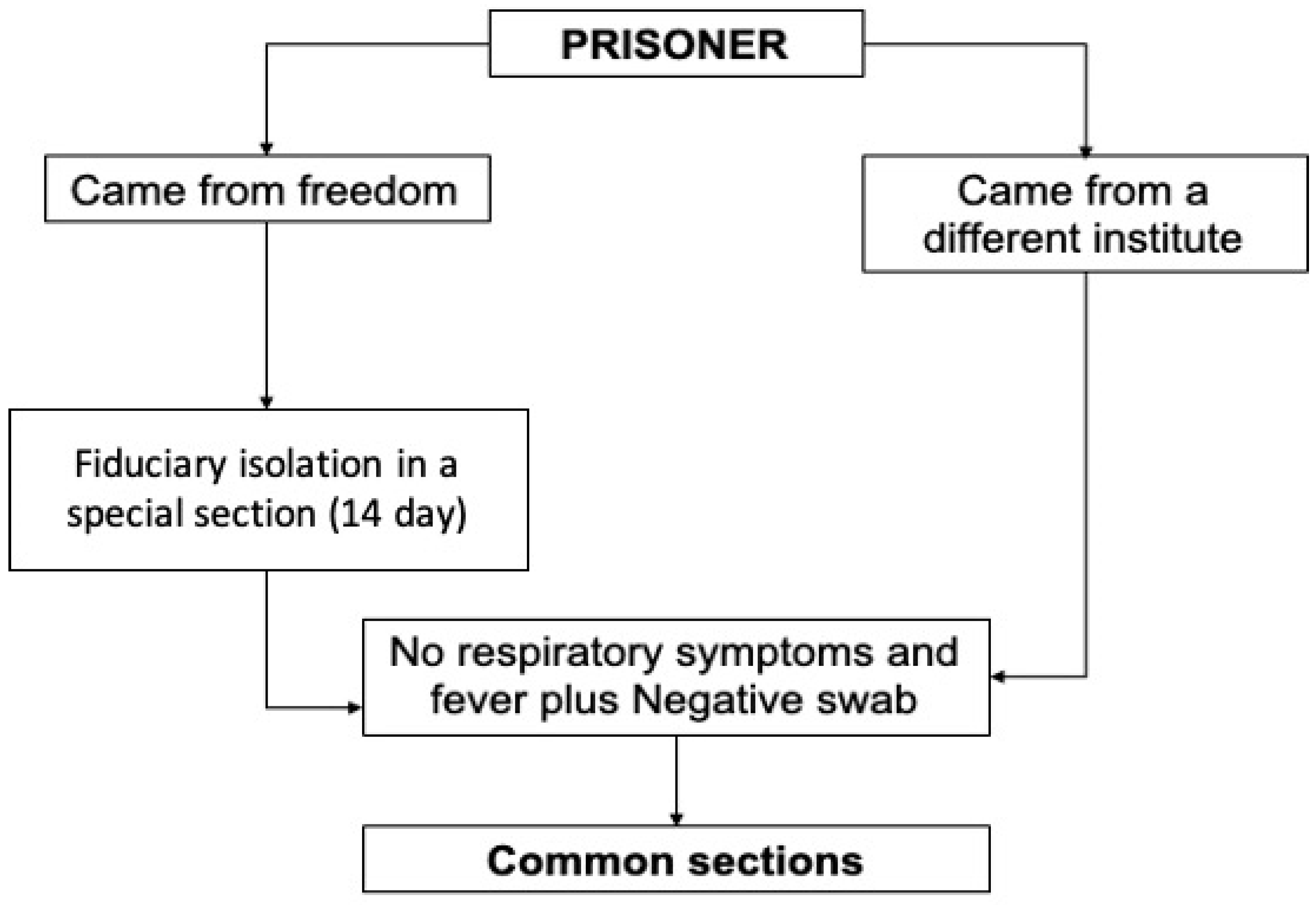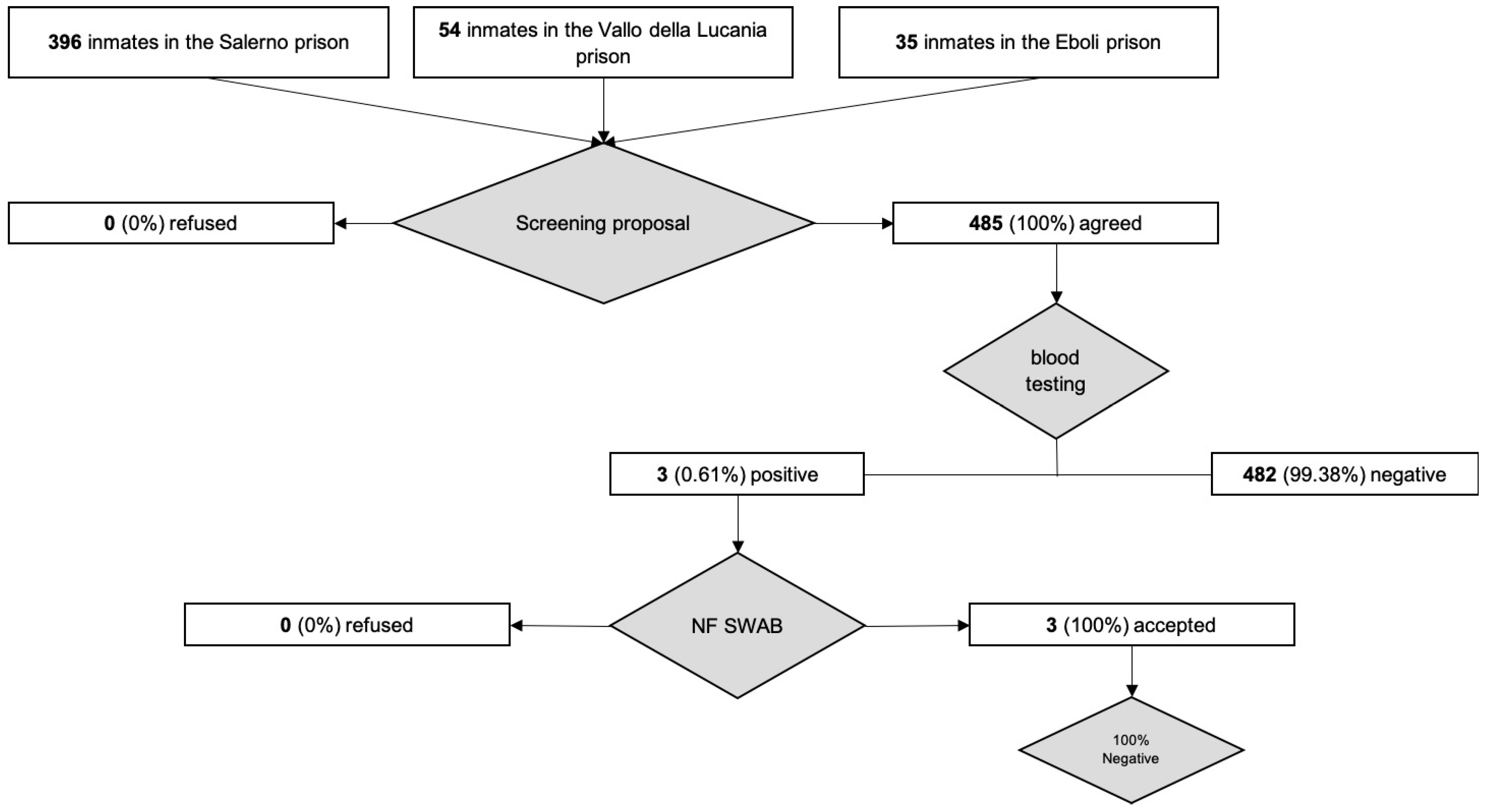COVID-19 Risk Management and Screening in the Penitentiary Facilities of the Salerno Province in Southern Italy
Abstract
1. Introduction
2. Materials and Methods
2.1. Patients and Methods
2.2. COVID-19 Serum Testing
2.3. COVID-19 Swabs
2.4. Statistical Analysis
2.5. Ethical Approval and Informed Consent
3. Results
4. Discussion
5. Conclusions
Author Contributions
Funding
Conflicts of Interest
References
- Rothan, H.A.; Byrareddy, S.N. The epidemiology and pathogenesis of coronavirus disease (COVID-19) outbreak. J. Autoimmun. 2020, 109, 102433. [Google Scholar] [CrossRef]
- Maiese, A.; Manetti, A.C.; La Russa, R.; Di Paolo, M.; Turillazzi, E.; Frati, P.; Fineschi, V. Autopsy findings in COVID-19-related deaths: A literature review. Forensic Sci. Med. Pathol. 2020. [Google Scholar] [CrossRef]
- Lauer, S.A.; Grantz, K.H.; Bi, Q.; Jones, F.K.; Zheng, Q.; Meredith, H.R.; Azman, A.S.; Reich, N.G.; Lessler, J. The Incubation Period of Coronavirus Disease 2019 (COVID-19) From Publicly Reported Confirmed Cases: Estimation and Application. Ann. Intern. Med. 2020, 172, 577–582. [Google Scholar] [CrossRef]
- Jiang, F.; Deng, L.; Zhang, L.; Cai, Y.; Cheung, C.W.; Xia, Z. Review of the Clinical Characteristics of Coronavirus Disease 2019 (COVID-19). J. Gen. Intern. Med. 2020, 35, 1545–1549. [Google Scholar] [CrossRef]
- Wang, Y.; Chen, Y.; Qin, Q. Unique epidemiological and clinical features of the emerging 2019 novel coronavirus pneumonia (COVID-19) implicate special control measures. J. Med. Virol. 2020, 92, 568–576. [Google Scholar] [CrossRef]
- Ahn, D.-G.; Shin, H.-J.; Kim, M.-H.; Lee, S.; Kim, H.-S.; Myoung, J.; Kim, B.-T.; Kim, S.-J. Current Status of Epidemiology, Diagnosis, Therapeutics, and Vaccines for Novel Coronavirus Disease 2019 (COVID-19). J. Microbiol. Biotechnol. 2020, 30, 313–324. [Google Scholar] [CrossRef]
- Zhai, P.; Ding, Y.; Wu, X.; Long, J.; Zhong, Y.; Li, Y. The epidemiology, diagnosis and treatment of COVID-19. Int. J. Antimicrob. Agents 2020, 55, 105955. [Google Scholar] [CrossRef]
- Le, T.T.; Andreadakis, Z.; Kumar, A.; Román, R.G.; Tollefsen, S.; Saville, M.; Mayhew, S. The COVID-19 vaccine development landscape. Nat. Rev. Drug Discov. 2020, 19, 305–306. [Google Scholar] [CrossRef]
- Li, H.; Liu, S.M.; Yu, X.H.; Tang, S.L.; Tang, C.K. Coronavirus disease 2019 (COVID-19): Current status and future perspectives. Int. J. Antimicrob. Agents 2020, 55, 105951. [Google Scholar] [CrossRef]
- Remuzzi, A.; Remuzzi, G. COVID-19 and Italy: What next? Lancet 2020, 395, 1225–1228. [Google Scholar] [CrossRef]
- Lazzerini, M.; Putoto, G. COVID-19 in Italy: Momentous decisions and many uncertainties. Lancet Glob. Health 2020, 8, e641–e642. [Google Scholar] [CrossRef]
- Camposeragna, A. Another effect of CoViD-19: Turning on the lights on the Italian prison situation. Recenti Prog. Med. 2020, 111, 287–289. [Google Scholar]
- Doyle, T.J. COVID-19, Prison Visits, and the Value of a Cup of Coffee. Ann. Intern. Med. 2020. [Google Scholar] [CrossRef]
- Caputo, F.; Gratteri, S.; Sacco, M.A.; Scalise, C.; Cacciatore, G.; Bonetta, F.; Zibetti, A.; De Aloe, L.; Sicilia, F.; Cordasco, F.; et al. Covid-19 emergency in prison: Current management and forensic perspectives. Med. Leg. J. 2020, 25817220923693. [Google Scholar] [CrossRef]
- Simpson, P.L.; Butler, T.G. Covid-19, prison crowding, and release policies. BMJ 2020, 369, m1551. [Google Scholar] [CrossRef]
- Crowley, D.; Cullen, W.; O’Donnell, P.; Van Hout, M.C. Prison and opportunities for the management of COVID-19. BJGP Open 2020, 4, 3. [Google Scholar]
- Cingolani, M.; Caraceni, L.; Cannovo, N.; Fedeli, P. The COVID-19 Epidemic and the Prison System in Italy. J. Correct. Health Care 2020, 1078345820929733. [Google Scholar] [CrossRef]
- Malta, G.; Zerbo, S.; Argo, A. The risk of the ‘prison-emptying’ effect in Italy due to the Covid-19 pandemic. Med. Leg. J. 2020, 88, 103–104. [Google Scholar] [CrossRef]
- Tozzo, P.; D’Angiolella, G.; Caenazzo, L. Prisoners in a pandemic: We should think about detainees during Covid-19 outbreak. Forensic Sci. Int. 2020, 2, 162–163. [Google Scholar] [CrossRef]
- Tuite, A.R.; Ng, V.; Rees, E.; Fisman, D. Estimation of COVID-19 outbreak size in Italy. Lancet Infect. Dis. 2020, 20, 537. [Google Scholar] [CrossRef]
- Voller, F.; Silvestri, C.; Martino, G.; Fanti, E.; Bazzerla, G.; Ferrari, F.; Grignani, M.; Libianchi, S.; Pagano, A.M.; Scarpa, F.; et al. Health conditions of inmates in Italy. BMC Public Health 2016, 16, 1162. [Google Scholar] [CrossRef]
- Nobile, C.G.; Flotta, D.; Nicotera, G.; Pileggi, C.; Angelillo, I.F. Self-reported health status and access to health services in a sample of prisoners in Italy. BMC Public Health 2011, 11, 529. [Google Scholar] [CrossRef]
- Esposito, M. The health of Italian prison inmates today: A critical approach. J. Correct. Health Care 2010, 16, 230–238. [Google Scholar] [CrossRef]
- Okano, J.T.; Blower, S. Preventing major outbreaks of COVID-19 in jails. Lancet 2020, 395, 1542–1543. [Google Scholar] [CrossRef]
- Dutheil, F.; Bouillon-Minois, J.B.; Clinchamps, M. COVID-19: A prison-breaker? Can. J. Public Health 2020, 111, 480–481. [Google Scholar] [CrossRef]
- Yang, H.; Thompson, J.R. Fighting covid-19 outbreaks in prisons. BMJ 2020, 369, m1362. [Google Scholar] [CrossRef]
- Sánchez, A.; Simas, L.; Diuana, V.; Larouze, B. COVID-19 in prisons: An impossible challenge for public health? Cad. Saude Publica 2020, 36, e00083520. [Google Scholar] [CrossRef]
- Henry, B.F. Social Distancing and Incarceration: Policy and Management Strategies to Reduce COVID-19 Transmission and Promote Health Equity through Decarceration. Health Educ. Behav. 2020, 47, 536–539. [Google Scholar] [CrossRef]
- Wang, J.; Yang, W.; Pan, L.; Ji, J.S.; Shen, J.; Zhao, K.; Ying, B.; Wang, X.; Zhang, L.; Wang, L.; et al. Prevention and control of COVID-19 in nursing homes, orphanages, and prisons. Environ. Pollut. 2020, 266, 115161. [Google Scholar] [CrossRef] [PubMed]
- Fróis, C. Covid-19 pandemic and social distancing in prisons. Anthropol. Today 2020, 36, 25–26. [Google Scholar]
- Cloud, D.H.; Ahalt, C.; Augustine, D.; Sears, D.; Williams, B. Medical Isolation and Solitary Confinement: Balancing Health and Humanity in US Jails and Prisons during COVID-19. J. Gen. Intern. Med. 2020, 35, 2738–2742. [Google Scholar] [CrossRef]
- Kinner, S.A.; Young, J.T.; Snow, K.; Southalan, L.; Lopez-Acuña, D.; Ferreira-Borges, C.; O’Moore, É. Prisons and custodial settings are part of a comprehensive response to COVID-19. Lancet Public Health 2020, 5, e188–e189. [Google Scholar] [CrossRef]
- Montoya-Barthelemy, A.G.; Lee, C.D.; Cundiff, D.R.; Smith, E.B. COVID-19 and the Correctional Environment: The American Prison as a Focal Point for Public Health. Am. J. Prev. Med. 2020, 58, 888–891. [Google Scholar] [CrossRef] [PubMed]
- Bahl, P.; Doolan, C.; de Silva, C.; Chughtai, A.A.; Bourouiba, L.; MacIntyre, C.R. Airborne or droplet precautions for health workers treating COVID-19? J. Infect. Dis. 2020, jiaa189. [Google Scholar] [CrossRef]
- Oladeru, O.T.; Tran, N.T.; Al-Rousan, T.; Williams, B.; Zaller, N. A call to protect patients, correctional staff and healthcare professionals in jails and prisons during the COVID-19 pandemic. Health Justice 2020, 8, 17. [Google Scholar] [CrossRef] [PubMed]



Publisher’s Note: MDPI stays neutral with regard to jurisdictional claims in published maps and institutional affiliations. |
© 2020 by the authors. Licensee MDPI, Basel, Switzerland. This article is an open access article distributed under the terms and conditions of the Creative Commons Attribution (CC BY) license (http://creativecommons.org/licenses/by/4.0/).
Share and Cite
Pagano, A.M.; Maiese, A.; Izzo, C.; Maiese, A.; Ametrano, M.; De Matteis, A.; Attianese, M.R.; Busato, G.; Caruso, R.; Cestari, M.; et al. COVID-19 Risk Management and Screening in the Penitentiary Facilities of the Salerno Province in Southern Italy. Int. J. Environ. Res. Public Health 2020, 17, 8033. https://doi.org/10.3390/ijerph17218033
Pagano AM, Maiese A, Izzo C, Maiese A, Ametrano M, De Matteis A, Attianese MR, Busato G, Caruso R, Cestari M, et al. COVID-19 Risk Management and Screening in the Penitentiary Facilities of the Salerno Province in Southern Italy. International Journal of Environmental Research and Public Health. 2020; 17(21):8033. https://doi.org/10.3390/ijerph17218033
Chicago/Turabian StylePagano, Antonio Maria, Aniello Maiese, Carmine Izzo, Adamo Maiese, Marcello Ametrano, Alessandra De Matteis, Maria Rosaria Attianese, Gaia Busato, Rosa Caruso, Michele Cestari, and et al. 2020. "COVID-19 Risk Management and Screening in the Penitentiary Facilities of the Salerno Province in Southern Italy" International Journal of Environmental Research and Public Health 17, no. 21: 8033. https://doi.org/10.3390/ijerph17218033
APA StylePagano, A. M., Maiese, A., Izzo, C., Maiese, A., Ametrano, M., De Matteis, A., Attianese, M. R., Busato, G., Caruso, R., Cestari, M., Biasi, S. D., Chiara, A. D., De Matteis, G., Goffredi, G., & La Russa, R. (2020). COVID-19 Risk Management and Screening in the Penitentiary Facilities of the Salerno Province in Southern Italy. International Journal of Environmental Research and Public Health, 17(21), 8033. https://doi.org/10.3390/ijerph17218033







